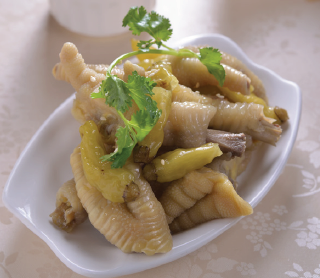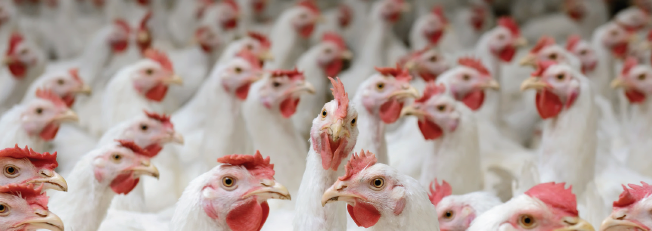
Content available at:
Melayu (Malay)
The broiler industry has made significant progress in the last two decades with genetic improvements and husbandry management that have made a very efficient and fast-growing broiler.
Management and nutrition have been geared to support bigger birds in the least amount of time.
Today’s broilers prioritize muscle deposition over skeleton and soft tissue development leading to structural integrity challenges, which can be exacerbated with gut health challenges in antibiotic free programs.
Footpad dermatitis is a skin inflammation that causes necrotic lesions on the plantar surface of footpads in poultry (Shepherd et al., 2010).

In some countries, chicken feet or paws are considered as gastronomic delicacy and at present constitute the third most important economic part of the chicken (following chicken breast and wings).
In addition, lesions in footpads can induce systemic infection in poultry, hence, footpad dermatitis is considered as a food safety issue (Matland, 1985; Campo et al., 2005; Managi et al., 2012).
Footpad dermatitis is a multifactorial condition that is caused by:
Wet litter has been reported to be the most central predisposing factor for footpad dermatitis development in poultry (Martland, 1984; Wang et al 1998; Mayne 2007).

Some researchers have reported that replacement of wet litter with dry litter improved the footpad lesions in about two weeks (Nagaraj et al, 2007; Taira et al., 2014).
Unfortunately, in the field, replacement of wet litter is not practical or economical, hence, alternative practices should be considered.
Trace minerals such as Zn, Cu, and Mn are known to play a role in maintaining the structural integrity of dierent tissues including skin (Manangi et al, 2012; Maricola 2003; Lansdown et al., 2007; Iwate et al 1999, Viera et al. 2013, Berger et al., 2007 Figure 1).
Nutraceuticals such as probiotics, prebiotics, or enzymes that improve intestinal integrity and improve fecal consistency and litter quality can also reduce footpad lesions (Van Dee Aa et al, 200*).
A variety of biomarkers for footpad lesion development and wound healing which can be used to better understand the pathology and etiology of footpad dermatitis and find strategies to intervene or prevent the development of footpad lesions and promote the wound-healing process (Chen et al., 2016; Figure 2).

Figure 3. Reduction in Zn Chelato MMHAC levels (30ppm zn) vs ZnSo (100ppm zn) help foot dermatitis.
Researchers (Figure 3; Manangi et al., 2012; Chen et al., 2017) have found that supplementation of combination of Zn, Cu and Mn trace minerals in the form of mineral methionine hydroxy analog chelated (MMHAC) improved growth performance, but also reduced footpad lesions by improving the wound healing process via promotion of collagen synthesis, deposition and organization, cell migration, matrix remodeling, angiogenesis; and regulation of inflammation (Figure 4).
CONCLUSIONS:
Trace minerals participate in the wound healing process by reducing inflammation, increasing expression of gens involved in vascularization, migration and proliferation of the cell and deposit and remodeling of collagen.
Supplementation trace mineral of higher availability like MMHAC, improves footpad dermatitis and skin integrity by improving the wound healing process which results in reduction of footpad dermatitis.
References upon consultation of the author.
Subscribe now to the poultry technical magazine
AUTHORS

Layer Longevity Starts at Rearing
H&N Technical Team
The Strategy for a Proper Infectious Bronchitis Control
Ceva Technical Team
Elevate Hatchery Performance with Petersime’s New Data-Driven Incubation Support Service
Petersime Technical Team
Maize and Soybean Meal Demand and Supply Situation in Indian Poultry Industry
Ricky Thaper
Production of Formed Injected Smoked Chicken Ham
Leonardo Ortiz Escoto
Antimicrobial Resistance in the Poultry Food Chain and Novel Strategies of Bacterial Control
Edgar O. Oviedo-Rondón
GREG TYLER INTERVIEW
Greg Tyler
Insights from the Inaugural US-RSPE Framework Report
Elena Myhre
Newcastle Disease: Knowing the Virus Better to Make the Best Control Decisions. Part II
Eliana Icochea D’Arrigo
Avian Pathogenic E. coli (APEC): Serotypes and Virulence
Cecilia Rosario Cortés
The Importance of Staff Training on Animal Welfare Issues in Poultry Industry
M. Verónica Jiménez Grez
Rodent Control is a Key Factor in Poultry Biosecurity and Sustainability
Edgar O. Oviedo-Rondón